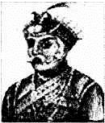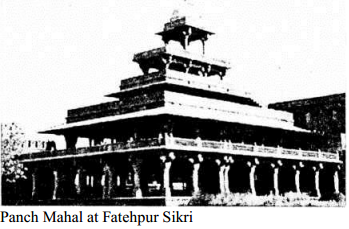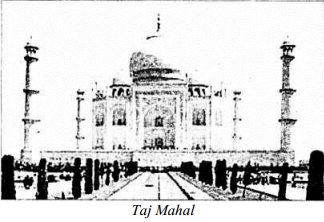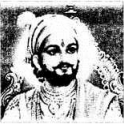Students can Download History Chapter 5 The Moghuls and the Marathas Questions and Answers, Notes, KSEEB Solutions for Class 9 Social Science helps you to revise complete Karnataka State Board Syllabus and score more marks in your examinations.
Karnataka State Syllabus Class 9 Social Science History Chapter 5 The Moghuls and the Marathas
Class 9 Social Science The Moghuls and the Marathas Textual Questions and Answers
I. Fill in the blanks with suitable words.
Question 1.
The founder of the Moghul dynasty was __________
Answer:
Babar.
Question 2.
The most famous emperor among the Moghuls was __________
Answer:
Akbar.
Question 3.
The king who built the Taj Mahal at Agra was ___________
Answer:
Shahjahan.
![]()
Question 4.
The Moghul emperor who established the new religion Din-e-Ilahi was ___________
Answer:
Akbar
Question 5.
Shivaji’s mother was __________
Answer:
Jijabai.
II. Answer the following questions by discussing with your group :
Question 1.
Describe the military achievements of Babar.
Answer:
After the death of his father, Umarsheikh Mirza, Babar ascend the throne of a small kingdom called Pharaghana in Afghanistan. At the time he was eleven years old. He lost his kingdom and wandered aimlessly. He got an inspiration to attack India. He invaded India five times. He defeated Delhi Sultan Ibrahim Lodhi in the battle of Panipath in 1556 A.D. and established Moghul dynasty in India. The battle he fought with Lodhi at Panipat is known a First Battle of Panipat. He made Delhi his capital. Then he defeated Rana Sangramsingh of Mewad, the Rajput King, Mediniraya of Chanderi and Ibrahim Lodhi’s brother, Goghra, Kanwa. Thus he established the Moghul rule in North India with his military achievements.
Question 2.
Explain the characteristics of the Sher-Shah administration.
Answer:
During the Shershah’s administration, the area of his administration limited to North India only, but at the present day, the area of administration is vast. It comprises the administration of 28 states including both north and south of India. The administration of Sher Shah was impartial and free from corruptive activities whereas, at present day, such an administration is not expected.
![]()
Secondly, if there was damage to crops during the movements of his troops, the government compensated the farmers. There was no impartiality in distributing the compensation, whereas at present if damages happened to the farmers, the compensations are distributed on corruptive lines.
Thirdly during Sher Shah’s administration, the tax system was just and uniform, whereas at present time it is not in a uniform system.
Fourthly Sher Shah was known for his impartial justice. Hence he had earned the title Sultan, the Just, His justice was impartial and free from corruption, whereas at present we never expect impartial justice and moreover to say that the judgments take a long time to be settled down. Sher Shah himself decided all the final appeals without any influence of outsiders, but today we do not expect the same.
This is the comparison between Sher Shah’s administration with present-day administration.
Question 3.
What are the areas won by Akbar?
Answer:
The areas wx>n Bengal, Malwa, Jaipur, Gondawan, Chittor, Kalinjar, Gujarat, etc.

Question 4.
Describe the contributions of Shahjahan to art and architecture.
Answer:
Shahjahan, who contributed the most to Moghul art and architecture, built a wonderful monument in Fatehpur Sikri and Agra.

Shahjahan built Akbari Mahal, Taj Mahal, Jahangir Mahal and a fort at Agra. He build forts in Lahore and Allahabad similar to the one in Agra. The country’s largest mosque, Jamia Masjid was also built at Delhi during Shahjahan’s period.

The building, Taj Mahal, built by Shahjahan in the memory of his Queen Mumtaz Begum is an excellent one and is considered as one of the seven wonders of the world and included in the list of UNESCO monuments.
![]()
Question 5.
Describe Shivaji’s system of administration.
Answer:
Shivaji was the most famous of Maharashtra’s kings. He was successful not only in expanding his kingdom but also in giving a good administration. He had organised an efficient administrative system in his vast kingdom.

He had divided his kingdom provinces. They were called Swaraj and Moghul areas. Marathi was the language of administration. There were ministers known as Asthapradhans in the central government to assist the King. In addition to them, there were other officials. Province, district and village were administrative units. His revenue system was favourable to farmers. In his administration, tradition system of justice was in practice. There were Brahmin judges, who used to give decisions base on smritis (Scriptures).
Question 6.
Explain the achievements of Bajirao I.
Answer:
Baji Rao, I was an unparalleled warrior. In his North expeditions, he conquered Gujarat, Malwa and collected Chouth and Sardeshmukhi taxes. Baji Rao, I defeated Nizam-ub-mulk and collected?
50 lakhs as war compensation. He conquered Salset and Basin from the Portuguese. When the Maratha leaders, Sindya, Holkar, Gaikwad, and Bhonsle decided to become independent, Baji Rao succeeded in suppressing their revolts and reestablished the glory of the Maratha empire. Hence, Baji Rao, I was called Shivaji II.